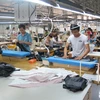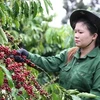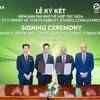Provinces in the Central Highlands have planted rubber trees on more than 64,000ha in the last two years, taking the region's total area under rubber to 174,720ha, the Tay Nguyen Steering Committee said.
Kon Tum, Gia Lai and Dak Lak provinces have the largest areas under rubber.
The trees have mostly been planted on infertile forest land.
The development of rubber cultivation in the region has created stable jobs and raised the incomes of tens of thousands of people, especially belonging to ethnic minorities.
Under the Government's policy of converting infertile forest land into rubber plantations, Central Highlands provinces have created hundreds of projects.
Gia Lai plans to grow rubber on 50,000 ha of such lands in 2009-15.
Kpa Thuyen, director of the Gia Lai provincial Department of Agriculture and Rural Development, said local companies had planted rubber trees on 502 ha this year.
This year, the province would meet the target of covering 12,000ha, taking the total area under rubber to 22,564 ha, he added.
Dak Lak plans to plant rubber trees in 77 communes, hoping to increase area under the crop to 41,530 ha by 2015 compared to the current 11,530ha.
The region's provinces together plan to develop 32,000ha this rainy season.
Tran Minh, deputy director of the Viet Nam Rubber Research Institute's Tay Nguyen Research and Technology Transfer Centre, said his centre would develop two models to help ethnic minority farmers in Kon Tum grow rubber trees.
They will be implemented in Kon Tum City and Dak Doa district on an area of 21 ha each with the participation of 30 households.
The centre would provide all the rubber saplings and 50 percent of fertilisers needed for growing the trees and help the households with planting techniques, Minh said.
The centre's experts would monitor the growth of three trees for three years, he added./.
Kon Tum, Gia Lai and Dak Lak provinces have the largest areas under rubber.
The trees have mostly been planted on infertile forest land.
The development of rubber cultivation in the region has created stable jobs and raised the incomes of tens of thousands of people, especially belonging to ethnic minorities.
Under the Government's policy of converting infertile forest land into rubber plantations, Central Highlands provinces have created hundreds of projects.
Gia Lai plans to grow rubber on 50,000 ha of such lands in 2009-15.
Kpa Thuyen, director of the Gia Lai provincial Department of Agriculture and Rural Development, said local companies had planted rubber trees on 502 ha this year.
This year, the province would meet the target of covering 12,000ha, taking the total area under rubber to 22,564 ha, he added.
Dak Lak plans to plant rubber trees in 77 communes, hoping to increase area under the crop to 41,530 ha by 2015 compared to the current 11,530ha.
The region's provinces together plan to develop 32,000ha this rainy season.
Tran Minh, deputy director of the Viet Nam Rubber Research Institute's Tay Nguyen Research and Technology Transfer Centre, said his centre would develop two models to help ethnic minority farmers in Kon Tum grow rubber trees.
They will be implemented in Kon Tum City and Dak Doa district on an area of 21 ha each with the participation of 30 households.
The centre would provide all the rubber saplings and 50 percent of fertilisers needed for growing the trees and help the households with planting techniques, Minh said.
The centre's experts would monitor the growth of three trees for three years, he added./.



















